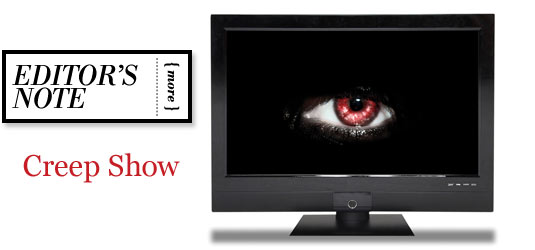Technology’s increasing reach into our personal lives might be crossing the line in some cases, but is it a necessary evil?
A news item out of the recent Consumer Electronics Show in Las Vegas caught my eye—in a creepy way. Manufacturers are creating next generation TVs that can actually watch you. Specifically, Samsung’s new software, dubbed S-Recommendations, provides program suggestions based on your viewing habits. So even if you feel it’s high time to graduate from your New Jersey-based reality series addictions, you will be offered a steady stream of like-minded content. There’d be no escaping the Garden State. LG takes Big Brother TV design a step further with a set that scans the viewer’s face and determines whether a child or an adult is watching, thereby delivering appropriate shows. But what if you happen to have a baby face? Will it be cartoons 24-7 for you? Or what if your viewing pleasures lean toward the more adult variety and the missus walks unexpectedly into the room? It’d sure be great if that TV could quickly sense a red face and change the channel to sports programming.

All kidding aside, might these new TVs be a case of over-programming? Do they really improve our lives? Aren’t they an intrusion into our right to decide, in complete privacy, what we watch? And must we now leave an electronic trail of guilty pleasures as evidence? If I happen to enjoy watching Jerseylicious, that’s nobody else’s damn business. It’s definitely not my TV maker’s or Nielsen’s or any brand seeking to market, I presume in this case, hair products or my nearest tanning salon.
I’ll admit that as an editor of a retail trade magazine my preference for privacy might run counter to marketers’ drive to know their customers as intimately as possible. Nevertheless, I don’t like the fact that my phone is following me everywhere I go, and I have zero desire to post on social media where I am. Who cares? Nor do I like the fact that my computer is a virtual memory bank of every site I visit and, for the record, the fact that every pop-up ad tries to sell me shoes. What’s more, there are cameras on almost every street corner where I live.
In case you’re wondering, I have nothing to hide. In fact, I believe I lead such a pedestrian life that I can’t imagine why anyone would want to know such personal information about me. Of course, I’m kidding myself. The personal data collection market shows no signs of slowing down. If you are in the retail business it makes sound business sense to know where consumers are going, what they are watching, reading, buying, liking, disliking, etc. It’s all potentially useful information, so long as it can be distilled in a meaningful way. Take Walt Disney World’s new electronic bracelets encoded with credit card information that will allow visitors to pay for things with a simple tap of the wrist as well as guide them to attractions. All the while, the company gains access to information on each of them—down to whether they shook Goofy’s hand. According to a report in the New York Times, Disney is banking on the $800 million-plus investment in MyMagic+ to pay much larger dividends in the long run based on the belief happier customers spend more and return more regularly. And knowing each attraction its 30 million annual visitors enjoyed and what they bought allows Disney to target market like never before.
Along those lines, this month’s Special Report (p. 16) delivers insights into the macro changes the 16- to 30-year-old New Millennials demographic is undergoing. For starters, these are not your baby or echo boomers in terms of their ethnic makeup, shopping habits and moral values. Call them the New Americans, and ignore this consumer sweet spot at your own peril—the generation is bigger in size than the two aforementioned ones. That doesn’t mean baby boomers should be put out to pasture. Far from it, as our retail profile (p. 54) on the sit-and-fit specialist, Brill’s Shoes in San Bernardino, CA, reveals. While baby boomers’ brand preferences may be more established, their product and shopping needs are changing dramatically due to advancing age. Brill’s, now in its 77th year, is a fine example of how catering to those needs—by the busloads from the nearby nursing homes, in fact—makes for a profitable and sustainable business strategy.
And let’s not forget our industry’s proverbial saving grace: Everyone wears shoes. Therefore, every demographic group is a mine that offers potential rewards. Any Big Brother-like technologies that help glean insights into 300 million-plus Americans cannot be all bad. Which brings me back to that news item about the latest TVs. Samsung’s OLED TV is capable of showing two full-screen programs simultaneously. Viewers don a pair of special glasses to watch his or her show. Just think of all the good that can stem from Americans no longer having to fight over the remote!




